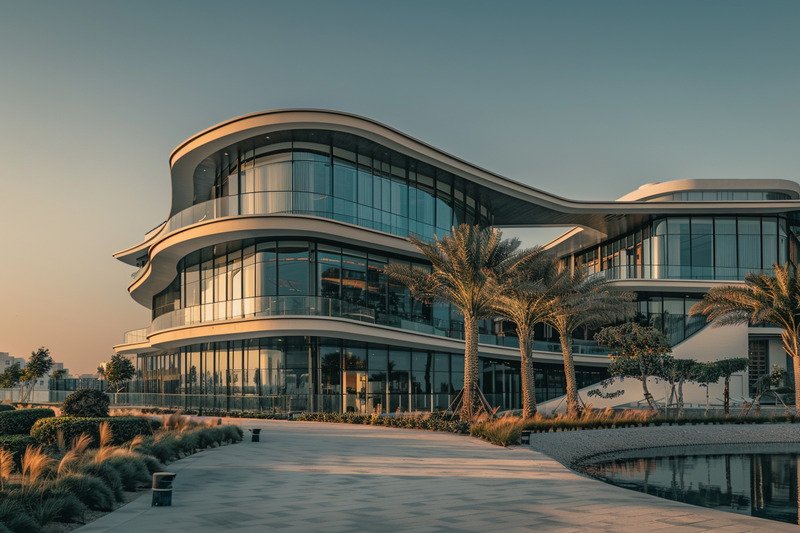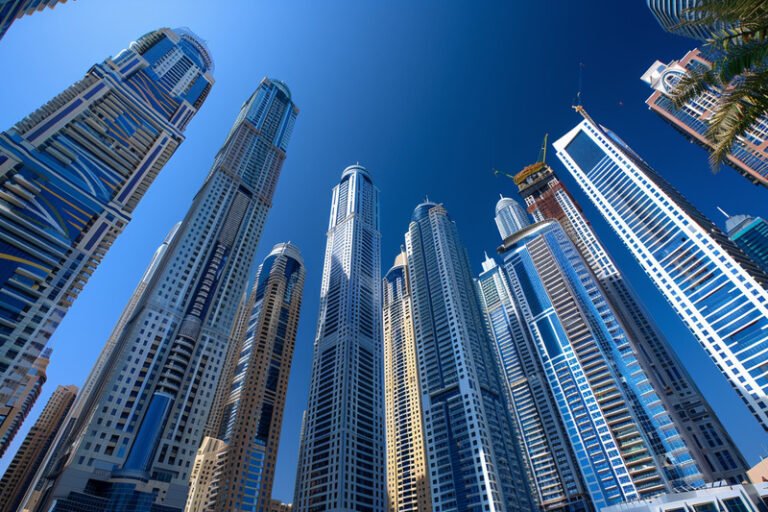Analysis of Average Rental Prices in Different Areas

When looking at average rental prices in Dubai, distinct trends emerge between urban and suburban neighborhoods. Urban areas like Downtown Dubai and Dubai Marina are pricier due to their proximity to business centers and upscale amenities.
Suburban areas like Mirdif and Al Warqa offer more budget-friendly options with larger spaces.
What factors contribute to these differences?
Location, property condition, and economic influences play significant roles.
Let us help you find the perfect property. Contact us to get started.
Urban spots benefit from convenience and luxury, driving up prices.
Suburbs offer more space and affordability, appealing to families and those seeking quieter living.
Understanding these aspects helps you navigate Dubai's rental landscape better.
Key Takeaways
Dubai's real estate market exhibits a diverse range of rental prices influenced by location, amenities, and economic factors.
Downtown Dubai and Dubai Marina command the highest rental rates, attributed to their luxury amenities and closeness to business hubs.
Suburban areas like Mirdif and Al Warqa offer more affordable rents and larger living spaces.
Location, property age, condition, and amenities significantly affect rental prices.
Economic conditions, including inflation, interest rates, and employment levels, directly impact rental costs throughout Dubai.
New developments in peripheral areas often provide budget-friendly rental options, contrasting with central urban locations.
Urban Rental Price Trends
As Dubai continues to grow, urban rental prices are rising steadily. This trend is driven by the increasing demand for housing in the city's bustling areas. People flock to Dubai for job opportunities, luxury amenities, and convenience, leading to fierce competition for available rentals. When demand outstrips supply, landlords can raise rents.
Economic factors also play a crucial role. Dubai often has higher living costs, including utilities, transportation, and groceries, which impact rental prices. Additionally, property taxes and maintenance costs for urban buildings are typically higher, contributing to increased rent.
Urban development projects further escalate rental costs. New infrastructure, such as enhanced public transportation, parks, and commercial centers, attracts more residents, driving demand and prices up. Gentrification in certain neighborhoods can turn previously affordable areas into more expensive locales.
Understanding these trends is essential for anyone considering renting in Dubai. Budget accordingly, factoring in both rent and associated living costs. Staying informed helps you make strategic decisions about renting in the city.
Suburban Rental Cost Analysis
Urban rents in Dubai are skyrocketing. Suburban neighborhoods offer a more affordable balance of convenience and cost. Choosing suburban living provides larger spaces for a lower price per square foot. Many areas feature parks, schools, and shopping centers, enhancing your quality of life without the city's hefty price tag.
Rental prices in suburban Dubai vary by neighborhood. Jumeirah Village Circle and Dubai Silicon Oasis offer competitively priced rentals. These areas provide various housing options, from apartments to townhouses, catering to different needs and budgets.
Transportation is another vital factor. Suburban areas often have good connectivity to the city via major highways and public transport. This makes commuting manageable, allowing you to save money while maintaining a reasonable commute to work or school.
Factors Influencing Rent
Several factors influence rental prices in Dubai, making it essential to understand what drives costs up or down.
First, the location of the property plays a significant role. Properties in areas like Downtown Dubai, Marina, and Palm Jumeirah tend to have higher rental prices. The demand for housing in these prime locations often exceeds supply, pushing prices up.
Second, the condition and age of the property affect rental costs. Newer buildings with modern amenities usually command higher rents compared to older structures lacking essential updates. Tenants are often willing to pay more for features like in-unit laundry, stainless steel appliances, and energy-efficient windows.
Third, the size of the rental unit matters. Larger units with more bedrooms and bathrooms generally cost more than smaller ones. However, the type of unit also plays a role; villas typically have higher rents than apartments or townhouses.
Economic Impact on Rentals
Economic factors like inflation, interest rates, and employment levels directly impact rental prices in Dubai. When inflation rises, the cost of living increases. Landlords often adjust rental prices upwards to cover higher expenses. This means you'll likely see a rise in your rent if the Dubai economy is experiencing high inflation.
Interest rates also play a pivotal role. When interest rates are low, borrowing money becomes cheaper. This leads more people to buy homes instead of renting, reducing demand for rental properties. Conversely, high interest rates make home buying less affordable, increasing rental demand and pushing prices up.
Employment levels are another significant factor. In a thriving economy with high employment, more people can afford higher rents. High employment rates increase demand for rental properties, driving up prices. Conversely, rising unemployment can decrease demand for rentals, causing prices to stagnate or drop.
Understanding these economic factors helps you anticipate changes in Dubai's rental market. Stay informed about inflation, interest rates, and employment trends to make better decisions regarding rental property investments or personal housing choices.
High-Demand Neighborhoods
High-demand neighborhoods in Dubai, like Downtown Dubai and Dubai Marina, are significantly influenced by economic factors, driving rental prices higher. Their popularity stems from proximity to business hubs, luxurious amenities, and vibrant lifestyle options. Demand for rental properties in these areas consistently outweighs supply, elevating prices.
Downtown Dubai's allure includes iconic landmarks like the Burj Khalifa and Dubai Mall. This central location attracts expatriates and locals seeking easy access to shopping, dining, and entertainment.
Dubai Marina appeals to those desiring waterfront living and a lively social scene. The marina's restaurants, cafes, and retail outlets, coupled with stunning views, make it a sought-after residential area.
Economic factors like employment rates, inflation, and foreign investment also play crucial roles. A thriving economy attracts more people to these neighborhoods, further driving rental prices. Understanding these dynamics helps you anticipate rental trends and make informed decisions about where to live or invest.
Comparing City Vs. Suburbs
When comparing city living to suburban life in Dubai, rental prices are a key factor. In urban areas like Downtown Dubai or Marina, rental prices are notably higher. This is due to the high demand for locations close to work, entertainment, and public transportation. City apartments often come at a premium because of their proximity to these conveniences.
In contrast, suburban rental prices in areas like Arabian Ranches or Mirdif are generally lower. Suburbs offer more space and less congestion, making them attractive to families and individuals seeking a quieter lifestyle. Lower population densities contribute to reduced demand and, consequently, lower rental costs.
The gap between city and suburban rental prices can vary widely. Suburbs of major metropolitan areas might've slightly higher rental prices compared to those of smaller cities. Evaluate not just the rental price but also commute time, lifestyle preferences, and long-term financial implications. By weighing these factors, you can make a more informed decision.
Amenities and Rental Prices
In Dubai, the availability of amenities like gyms, pools, and security services significantly impacts rental prices. Properties with state-of-the-art fitness centers and swimming pools command higher rents. These amenities provide added convenience and lifestyle benefits that many renters are willing to pay a premium for.
Security services, including gated communities and on-site security personnel, increase rental prices. Safety is a top priority for many renters, making such properties more desirable.
High-speed internet, modern kitchen appliances, and in-unit laundry facilities also escalate rental costs. These features offer greater comfort and efficiency.
Proximity to essential services like grocery stores, public transportation, and schools further influences rental prices. Properties near these conveniences are more expensive due to added ease of access.
In urban areas like Downtown Dubai, amenities such as rooftop gardens, co-working spaces, and concierge services can lead to higher rental rates.
Seasonal Rental Variations
Rental prices in Dubai fluctuate with the seasons, affecting how much you might pay at different times of the year. During the cooler months from October to April, demand for rental properties increases. This is largely due to the influx of tourists and expatriates who prefer Dubai's milder climate. Consequently, rental prices rise during these months.
In contrast, from May to September, the extreme heat lowers rental demand. This leads to a surplus of available properties. As a result, landlords may reduce rental prices to attract tenants, providing more affordable options.
Seasonal events and holidays, such as the Dubai Shopping Festival or Ramadan, can also influence rental prices. These events temporarily boost demand, causing short-term price hikes.
The end of the school year in June and the start in September often see families relocating. This impacts rental dynamics and prices.
Understanding these seasonal variations can help you plan your rental search more strategically. Timing your move during periods of lower demand may secure you a better deal.
Regional Rental Differences
Dubai's rental prices vary by district, influenced by factors like location, amenities, and demand.
Expect to pay a premium in Downtown Dubai due to its central location, luxury buildings, and proximity to landmarks like the Burj Khalifa. High demand drives prices up significantly.
More affordable options exist in districts like Deira and Bur Dubai, reflecting their older infrastructure and lower demand.
If you fancy a beachfront lifestyle, Jumeirah Beach Residence (JBR) and Dubai Marina are popular choices. These areas command higher rents due to modern amenities, scenic views, and vibrant community life.
Suburban areas like Mirdif and Al Warqa provide budget-friendly options, ideal for families seeking spacious accommodations without the high costs of central locations.
Emerging districts like Dubai South and Dubailand offer lower rental prices. These locations are farther from the city center but feature new developments and growing amenities.
Consider your lifestyle needs, commute preferences, and budget when selecting where to rent in Dubai.
Future Rental Price Predictions
Looking ahead, rental prices in Dubai will fluctuate based on economic trends and development projects. The city's rapid growth and constant construction create a dynamic market.
Areas like Downtown Dubai and Dubai Marina are likely to see price increases due to prime locations and high demand. Peripheral areas with new developments could offer more affordable options to attract residents.
The economic health of Dubai significantly impacts rental prices. A robust economy with low unemployment rates typically raises rental demand and prices. Conversely, economic downturns can lead to a surplus of available properties, causing prices to drop. Government policies, such as rent control measures or incentives for foreign investors, also influence the market.
Technological advancements and smart city initiatives will shape future rental trends. Properties with integrated smart technologies may command higher rents. International events like Expo 2020 can cause short-term price spikes by attracting visitors and temporary residents.
Understanding these factors will help you navigate Dubai's rental market effectively.
Conclusion
To understand Dubai's rental landscape, it is crucial to consider urban and suburban distinctions. Key factors such as location and property condition play a significant role, along with economic impacts. High-demand neighborhoods and amenities have a direct influence on rental prices. Seasonal fluctuations and regional differences add complexity to the market.
Analyzing these elements individually provides valuable insights into current trends and helps forecast future rental changes. Staying updated on the market dynamics assists both tenants and investors in navigating Dubai's rental market efficiently.
Let us help you find the perfect property. Contact us to get started.






